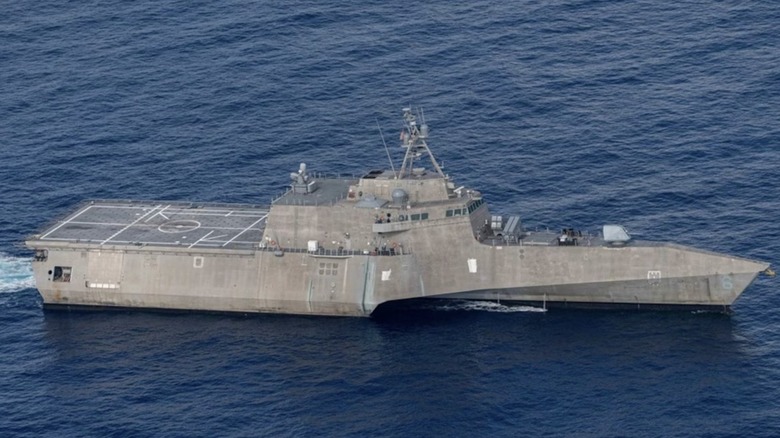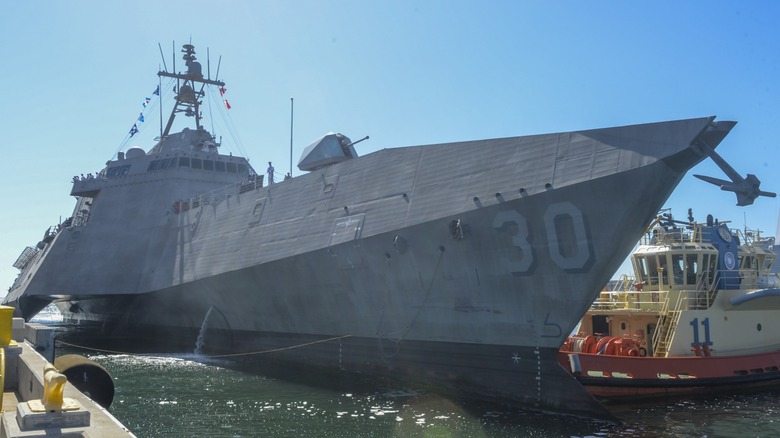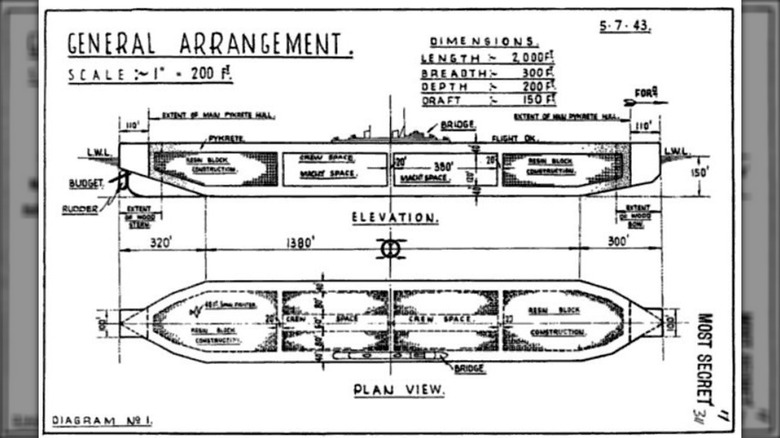5 Of The Weirdest Warships Ever Made
The greatest inventions and engineering feats of our times — from skyscrapers to bridges to ships — didn't happen overnight. They were built on the backs of years of innovations, and the results of painstaking trial and error. When it comes to brainstorming, there are no wrong answers — even the most outside-the-box concepts can sometimes pay off, or at the very least inspire better ideas.
Just as there have been unorthodox planes and cars, the same is true for seafaring vessels — including those designed for armed conflict. Some of these never passed the concept or prototype stages, while others have been successful enough to be mass-produced for major navies. Warships are typically costly endeavors and you won't find governments spending money on ideas that are weird for weird's sake. The bizarre concepts found in the strangest seacraft almost always serve a purpose, whether it's to improve efficiency, provide a strategic advantage, or save money in construction.
There have been many innovative designs over the centuries, with some a lot more eccentric than others. For example, one of the strangest ships ever used by the U.S. Navy was the USS Wolverine, a wooden aircraft carrier stationed in Lake Michigan during World War II. Converted from a side-wheel luxury steamer built in 1912, the USS Wolverine greatly supported the war effort as pilots used it to practice the difficult landings and takeoffs that carriers require. Unusual designs haven't been limited to support and training vessels, either. Navies have also experimented with true warships equipped with armor and weapons, some of which have seen combat or are still in use today. Here are five of the weirdest warships ever made.
Tucumcari (PGH-2)
The Tucumcari (PGH-2) was one of multiple hydrofoil boats used by the Navy during the Vietnam War and as the U.S. sought to innovate and improve military technology across the board during the Cold War arms race. The wing-like foils mounted under the hull of a hydrofoil vessel lift it above the water once it reaches a certain speed. With the ship moving above the surface, there is far less drag, allowing it to move faster and more efficiently.
With this design, the Tucumcari and similar seacraft like the USS High Point and USS Flagstaff look more like beefed up recreational speedboats than warships, gliding over the water like ships on stilts. Designed and constructed by Boeing, the Tucumcari was 721 feet long with a 19-ft beam. In addition to two wings beneath the ship's stern, a single, third wing was located under its bow in a canard configuration. The warship didn't use any propellers and instead moved by using water jet propulsion. Gas- and diesel-powered turbine engines pumped 120 tons of seawater per minute (twice the weight of the ship) to push the Tucumcari on its three wings.
Entering active service in 1968, the armed patrol boat conducted several missions in Vietnam before being transported to Europe to participate in naval exercises that showcased hydrofoil technology to NATO allies. It was later deployed to the Caribbean before running aground in Puerto Rico and being damaged beyond repair during the recovery. The U.S. military stopped using hydrofoil ships like the Tucumcari because they turned out not to be cost-effective to maintain and aren't nearly as effective in open oceans, which navies began to increase their focus on later in the Cold War and beyond.
Novgorod
With a freeboard of just 13 inches between its deck and the water, the Civil War-era USS Monitor was quite a difficult target for its enemies. After its infamous battle with the Merrimack in 1862, other ships with this low-profile, flat-deck design became informally known as Monitor-style or Monitor-class. One of the most famous of these is the Novgorod, built by Imperial Russia in the 1870s. What makes the ship even weirder is that it's in the shape of a circle, with a diameter of 101 feet. Combined with its flat profile, it looks a lot like a UFO — a floating saucer. At its center was a rotating turret of heavy cannons that could fire in any direction.
The idea of a circular warship predated the Novgorod, but the Russian Navy went ahead with its construction for a specific reason — its round design allowed it to use bigger guns than traditional warships. The recoil of extremely powerful artillery can cause ships to roll, which wasn't an issue for the Novgorod since its width was the same as its length. Heavily armed and armored, the Novograd wasn't classified as a naval ship but rather a "floating fortress" that protected the shores of Sevastopol, a port city on the Black Sea. Its mere presence acted as a deterrent for any enemies considering an attack or invasion.
There were plenty of downsides to the unorthodox structure of the Novgorod. Unable to cut through the water with a pointed bow, it was very slow and practically useless for pursuing other ships. Its low deck also made it vulnerable to rougher waters. While its shape was designed to prevent rolling while firing large guns, there were reports of it spinning instead. Despite these issues, it helped protect Russia's coast until 1903.
Independence-class
While the U.S. Navy focuses most of its energy on the open seas, it still operates some ships built for littoral warfare — armed conflict that is waged much closer to the coast. Some of the newest warships in the fleet include the Independence-class and Freedom-class ships, which are designed for littoral combat but are also versatile enough to sail on the open ocean when necessary.
The Independence-class is the weirder of the two, as it has a tri-hull structure as opposed to the more traditional monohull of the Freedom-class. This trimaran layout gives Independence-class ships, such as the USS Jackson and USS Tulsa, a striking and unique look that resembles a catamaran with a narrow pointed hull in the middle cutting through the water like a sharp sword. This design allows the warship to be incredibly quick and agile and makes the Independence-class one of the fastest ships in the Navy, capable of speeds over 44 knots (50 mph).
For its Littoral Combat Ship (LCS), the Navy uses modular payloads that can be customized for a given vessel's mission. It can be armed with 57 mm guns and RIM-116 and SEARAM missiles for combat as well as be used for surveillance, with a suite of modern sensors, including 3D air search radar and fully digital nautical charts. The Independence-class can accommodate up to 75 sailors, though usually has a crew of 40-50. Over 15 ships in the class have been built since 2002. The Independence-class and its littoral capabilities are still vital to naval operations and a new ship in the class — the PCU Pierre — will be commissioned later this year.
Habakukk
As aircraft became increasingly important for 20th century warfare, so did the ships that launched them. At one point during World War II, the British Navy considered building a carrier larger than ever before, with the ability to hold and deploy up to 300 aircraft (for comparison, carriers built later in the war could house 90 planes). This behemoth, called Project Habakkuk, wasn't just notable for its proposed size, but also the audacious plan to build the aircraft carrier out of ice and wood pulp. This ice and pulp mixture, called pykrete, would allow the British to use the large amounts of steel typically needed for aircraft carriers for other purposes in the war effort.
Construction of the Habakkuk was planned to take place around a natural iceberg near Canada in the North Atlantic. German U-boats patrolling the Mid-Atlantic were an increasing threat, prompting the need for aircraft as a defense. Because aircraft at the time didn't have the range to reach those waters from the U.K., the massive size of the Habakkuk could serve as an incredibly strategic, man-made island for planes to land, refuel, and take off.
Its engineers planned for the Habakkuk to be 2,000 feet long and 200 feet wide, which is larger than the modern-day Gerald R. Ford-class carrier — the biggest warship ever made. It would've weighed around 2 million tons and only been able to sail at 7 knots (8 mph). The project was scrapped though for being too cost prohibitive and because advancing technologies made more traditional aircraft carriers more practical to build. However, a proof-of-concept scale model was built that was 60 feet long and 30 feet wide, successfully proving that the idea could work, with its ice-built structure kept frozen by a motorized cooling system.
IRIS Shahid Mahdavi
In February 2025, Iran launched a highly-unusual aircraft carrier, the IRIS Shahid Bagheri, which has a sharp upward slope at one end. Converted from a container ship, it's smaller than most modern carriers and is designed to launch unmanned drones rather than fighter jets. Iran has an even weirder warship in its fleet, however — the IRIS Shahid Mahdavi. Rather than a floating runway for planes or UAVs, the IRIS Shahid Mahdavi is a helicopter carrier.
One of the differences between an aircraft carrier and a helicopter carrier is that it doesn't require nearly as much length, since the aircraft it carries are capable of vertical takeoffs and landings. This also allows it to be smaller and deploy with less crew. Like the IRIS Shahid Bagheri, the IRIS Shahid Mahdavi is particularly odd as it's a converted container ship. Both carriers have been called modern-day Q-ships, which were commercial vessels used during both World Wars that were outfitted with guns and which could masquerade as civilian ships before launching surprise attacks on unsuspecting enemies.
The IRIS Shahid Mahdavi became particularly important this year after Iran and Israel exchanged missiles and explosive drones in June 2025. With the conflict threatening to continue and explode into something larger, the IRIS Shahid Mahdavi could find itself a key player in a major war. Unfortunately, armed conflicts around the globe show no signs of going away anytime soon, so it's very possible that the 21st century will see warships on the horizon that are even deadlier, more innovative, and weirder than ever before.



